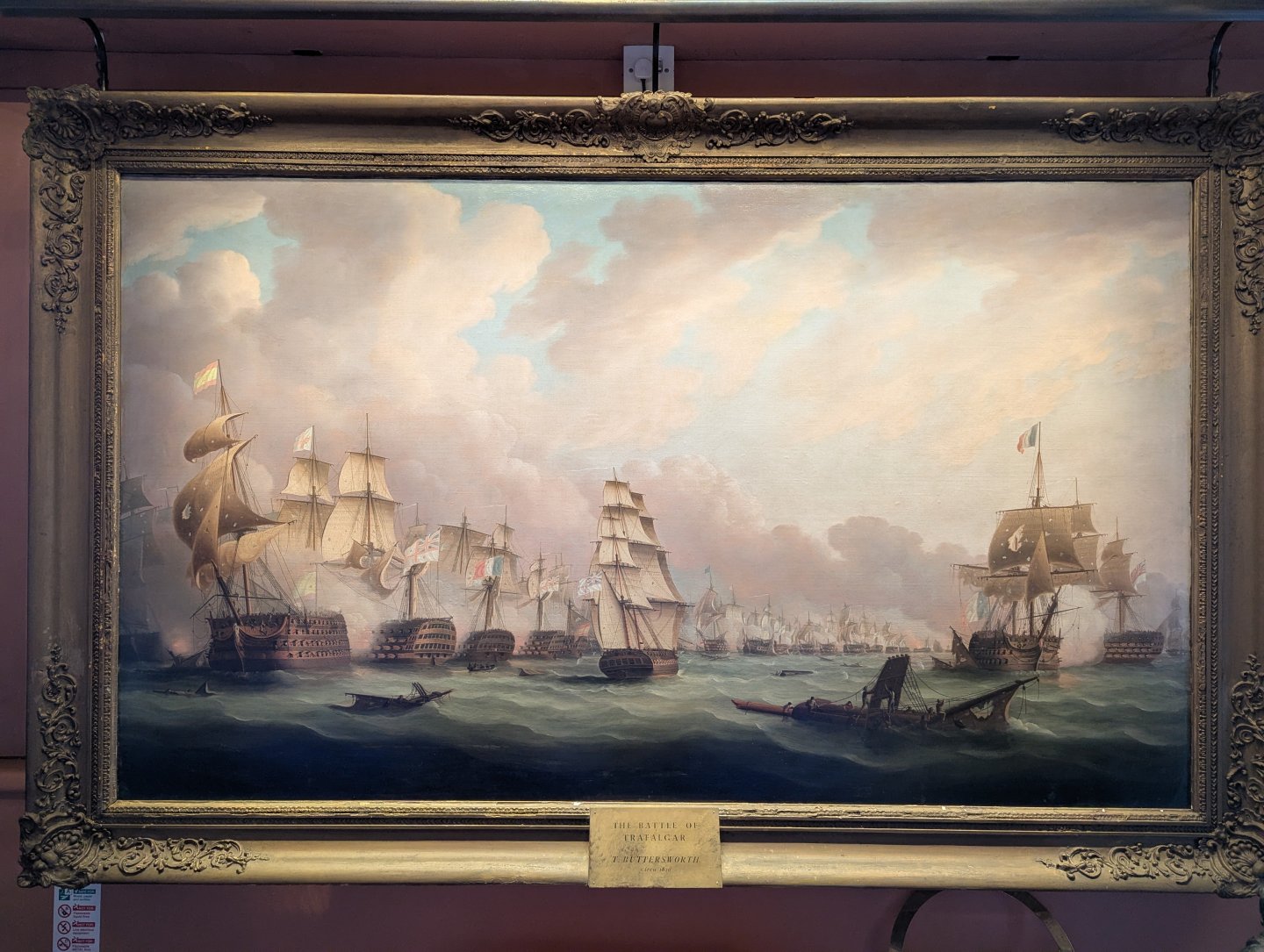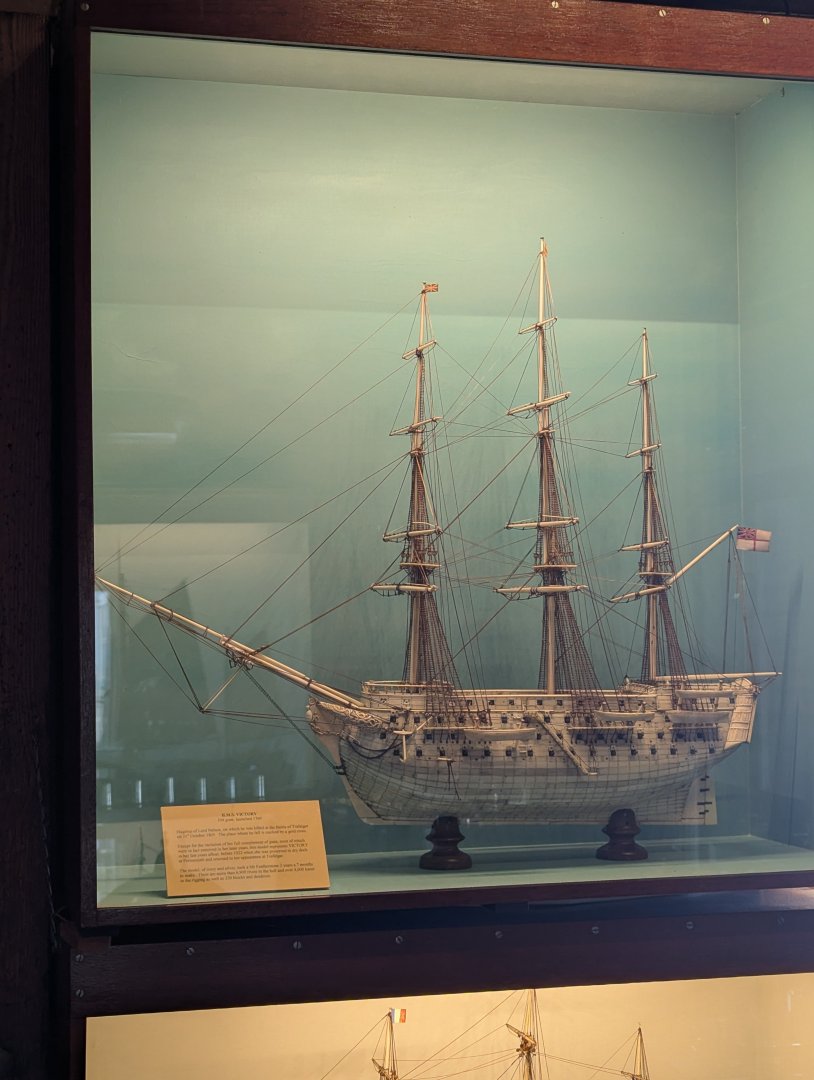-
Posts
1,202 -
Joined
-
Last visited
Content Type
Profiles
Forums
Gallery
Events
Everything posted by Kevin-the-lubber
-
As ever, excellent work, and the foot bars make sense. While the boats on display at Portsmouth may only be contemporary examples, the one that looks like the launch has a planked 'deck' at about 1/3rd height vertically, sitting on cross bars. I can see what looks like a duckboard underneath this in my photos, sat on the frames. I can also just about make out the slots for the capstan, though neither this nor the little stern gantry are present on the boat. Nor is there anything that would give clues about the rigging. I imagine this launch, like the Vic itself, has had a few improvements and adaptations made over the years, and the deck may have been added as a more comfortable solution once load carrying became less relevant. It's frustrating that it's so difficult to get good photos of the boats (and that they seem to be a repository for offcuts and wood scraps). Maybe next time I'll ask if I could go inside the enclosure - it turns out I have a free pass for the historic dockyard and V@P so can visit as often as I like.
-
Indeed he is and, even though I can almost hear the screams of terror through having all those guns run out when she's heeled over so far, I quite like his paintings. It's intriguing that the ochre seems to continue round the counter.
-
I echo that. From a technical view alone it's a superb piece of work, but the artistry is what really catches the eye. I certainly know what you mean about 15 iterations, sometimes even that isn't enough, is it.
-
As I'm still nowhere near ready to post an update on the model, I wanted to share a couple of photos in the meantime. I took these yesterday while visiting the Sir Max Aitken Museum in Cowes on the Isle of Wight. If you happen to be visiting the Victory in Portsmouth and have spare time and a few pounds for the ferry crossing, this is a nice little treasure trove of nautical artifacts. Its not very large but entry is free and the lovely Isle of Wight is always worth the visit anyway. The first is Trafalgar by Thomas Buttersworth. I found this to be an interesting depiction, with Victory (first british ship from the left) looking fairly different to the ship we see in Portsmouth. Discussion welcome! The second is an exquisite, bone and silver carved model of the Victory. I'd say the scale was around 1:150 or thereabouts. While it looks like the modelmaker needed to take licence with a few details, it's an impressive piece of work.
-
What an impressive result. While the artists that painted the original are certainly to be admired, doing the same in miniature is itself quite an achievement. If you hadn’t explained the method I would have guessed you’d had a professional outfit make you a decal. And thanks for the tips. I had to look up artists frisk as I had no idea what that was, but it’s something I already have a use/need for on a non-ship project, and I think I’ll take out that second mortgage and try a bottle or two of Golden paint for airbrushing. I’ve mostly used Vallejo Model Air and, while they are affordable and often very good, most colours tend to clog my (good quality) airbrush such that I almost dread airbrush sessions. If Golden turn it into a pleasure I’ll gladly pay the three times the cost premium.
-
Good plan. That’s a very nice looking build and I’d think you’re bound to have a time when you’re sat somewhere nice with too much time on your hands. That’s what stops us buying - our current plan, once my wife retires, is to rent long term I.e. two or three months at a time, to do some of the longer journeys, but be able to come back home for the winter etc.
-
I think all methods are as valid as each other. Although it was before my time I expect some traditional model-makers scoffed at all those injection-moulded abominations when they first hit the shelves. Though I'd still love to have the patience, hand skills and eye for carving that you have Marc.
- 2,623 replies
-
- heller
- soleil royal
-
(and 9 more)
Tagged with:
-
Keep in mind that you both make far more progress than me! Even now I have somewhat mixed feelings about it all, but I suppose I'm in too deep now.
- 2,623 replies
-
- heller
- soleil royal
-
(and 9 more)
Tagged with:
-
I zap these with my soldering blowtorch, but that said, I can’t remember the last hairy print I had. I used to be plagued by that but think the filament heater solved that problem.
- 184 replies
-
Thanks both, I just thought I'd ask on the off-chance that you would know off the top of your head, but I don't want to hijack your log!
- 184 replies
-
You've already gone way beyond my knowledge but google tells me 1/3 to 1/2 would be fine. This thing won't be turning heavy loads, probably about 1 kilo or thereabouts.
- 184 replies
-
That's really not bad at all for FDM printing, is it. I'd also chop off the funnels and do them separately - you can probably do that in the slicer. Ian, can I pick your brains a little about motors, as you seem to know a sight more than me about these. I'm making various simple machines for other arty projects and one of these is a roller machine, that is quite similar to a rock tumbler. I could just buy a rock tumbler but I like solving puzzles and making stuff, besides which I can make everything apart from the motor. I've used a small, cheap, 220V synchronous 5 rpm motor for proof of concept, it does the job but gets very hot after 30 mins continuous use. I need something that can run for hours, maybe even days. It also reverses direction at will, there must be some kind of internal counter that determines that this time it'll be clockwise, next time anti. Ideally I'd have control over that and even more ideally, I'd be able to control the speed via electronics rather than gears. Any suggestions, pointers?
- 184 replies
-
Phil, did you change your mind about closing this log? As a follower, I received an email overnight like so (below) but it doesn't show up in the log? GrandpaPhil has posted a comment on a topic, HMS Victory by GrandpaPhil - Mantua - Scale 1:98 - Kit-Bash - Aborted Posted in HMS Victory by GrandpaPhil - Mantua - Scale 1:98 - Kit-Bash - Aborted I am closing out this build log. I learned a lot from working on this model, but I have no real desire to continue it. I have ... Go to this Post
-
I think our views are fairly similar Phil. It's just another material and like all the others it has pro's and con's. I use whatever seems most suitable for the job at hand, be that wood, metal, resin, paper, card and the clear poly-something-or-other found on cake boxes which is great for window glass 😁. At least that's what I tell my wife when asking her to buy yet more chocolate eclairs. (Don't tell her but I actually use transparent resin coated with high gloss lacquer). Have you tried ABS-like resins? I prefer to stiffen them up a bit by mixing with a bit of tough or rigid resin but it does make parts pretty tolerant of being bent etc. I print window bars at 0.25mm - 0.3mm without issue but below that would be pushing the boat out a bit too far, in most cases. Anyway, that is a gorgeous little boat and an impressive bit of model-making to do it this small.
- 54 replies
-
- 18 ft cutter
- ships boat
-
(and 1 more)
Tagged with:
-
You’ve made a lovely job of this Phil, especially at this scale. Ply at 0.8mm is seriously thin stuff! It won’t surprise anyone that I have a different view about 3D development and printing. It opens up a new model making avenue in much the same way as injection moulding and die casting made model building accessible to gazillions of school kids. But each to their own of course. I’d just add that resin printing has come a long way. Parts can be much more robust than you might think and I have no end of objects sat unpainted and in full sun without the slightest signs of deterioration. I suspect the things I make will long outlast me!
- 54 replies
-
- 18 ft cutter
- ships boat
-
(and 1 more)
Tagged with:
-
Have you thought of making it from card, possibly stiffening this up with diluted wood glue to reduce feathering? Just thinking that it’s much easier to cut card with a scalpel than plastic. (It doesn’t really help but this would probably come out well as a resin print). ps. Not just any old card - I mean the good quality, smooth surface stuff from an art supplies shop.
-
I stuck with it all the way until I just couldn't do what I wanted any more. Every so often I have reason to go back into my TinkerCAD account, usually to retrieve something I made for gardening or DIY, and I'm surprised at just how much you can do with it.
- 184 replies
-
Are you still using TinkerCAD? In F360 (and, I imagine most of CAD packages) you’d quickly loft this. It looks like you’ve already become very adept at 3D Ian. The scraps photo made me smile. I bet we all have a big box like that somewhere in the workshop!
- 184 replies
-
This is an amazing build Michael, I will need to read the whole log as at first I thought this was a scratch build, wood POF at something like 1:78! Your Victory is beautiful too, and as for the Vasa - gosh, you really do rise to the challenge, don't you!
- 254 replies
-
- Sovereign of the Seas
- Airfix
-
(and 1 more)
Tagged with:
-
It still looks great from here. As others have said, maybe inspiration will come with the passage of a bit of time, but in any case maybe you could look at it as a 99% success, which really isn't bad score, is it. There are some exquisite models on this site but I think this kit is on another level in terms of complexity and detail.
-

3D printing material question
Kevin-the-lubber replied to CPDDET's topic in CAD and 3D Modelling/Drafting Plans with Software
Yes, this resin can be machined, but do be careful, resin has a relatively low breaking threshold. If I was you I would ask them to give me some scrap pieces if possible, to practice on, or else get an extra print done. That said, you might be surprised at just how thin parts can be printed. I regularly print objects with walls that are only 0.2mm thick, including tubes. However the risk of print failure is higher on these parts, which increases costs, so commercial printers may be reluctant to take that risk. -

3D printing material question
Kevin-the-lubber replied to CPDDET's topic in CAD and 3D Modelling/Drafting Plans with Software
Go for the elegoo abs-like grey. This will have a bit of flex whereas the elegoo standard will be more rigid and prone to breaking. Grey is a very good colour for seeing the detail quality.
About us
Modelshipworld - Advancing Ship Modeling through Research
SSL Secured
Your security is important for us so this Website is SSL-Secured
NRG Mailing Address
Nautical Research Guild
237 South Lincoln Street
Westmont IL, 60559-1917
Model Ship World ® and the MSW logo are Registered Trademarks, and belong to the Nautical Research Guild (United States Patent and Trademark Office: No. 6,929,264 & No. 6,929,274, registered Dec. 20, 2022)
Helpful Links
About the NRG
If you enjoy building ship models that are historically accurate as well as beautiful, then The Nautical Research Guild (NRG) is just right for you.
The Guild is a non-profit educational organization whose mission is to “Advance Ship Modeling Through Research”. We provide support to our members in their efforts to raise the quality of their model ships.
The Nautical Research Guild has published our world-renowned quarterly magazine, The Nautical Research Journal, since 1955. The pages of the Journal are full of articles by accomplished ship modelers who show you how they create those exquisite details on their models, and by maritime historians who show you the correct details to build. The Journal is available in both print and digital editions. Go to the NRG web site (www.thenrg.org) to download a complimentary digital copy of the Journal. The NRG also publishes plan sets, books and compilations of back issues of the Journal and the former Ships in Scale and Model Ship Builder magazines.





